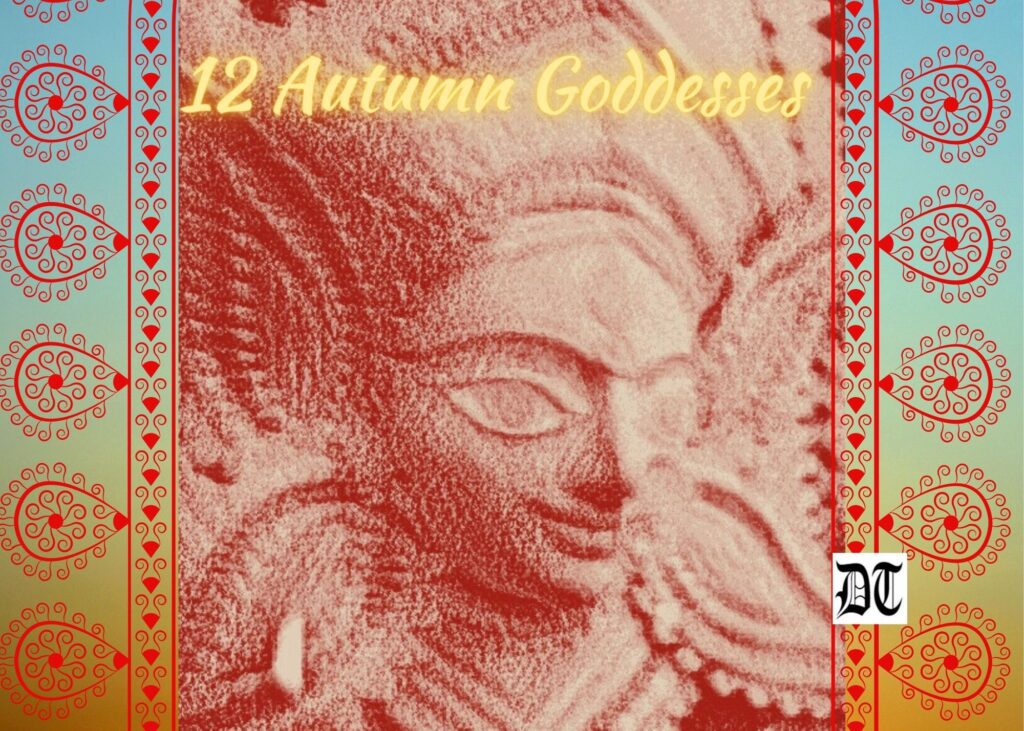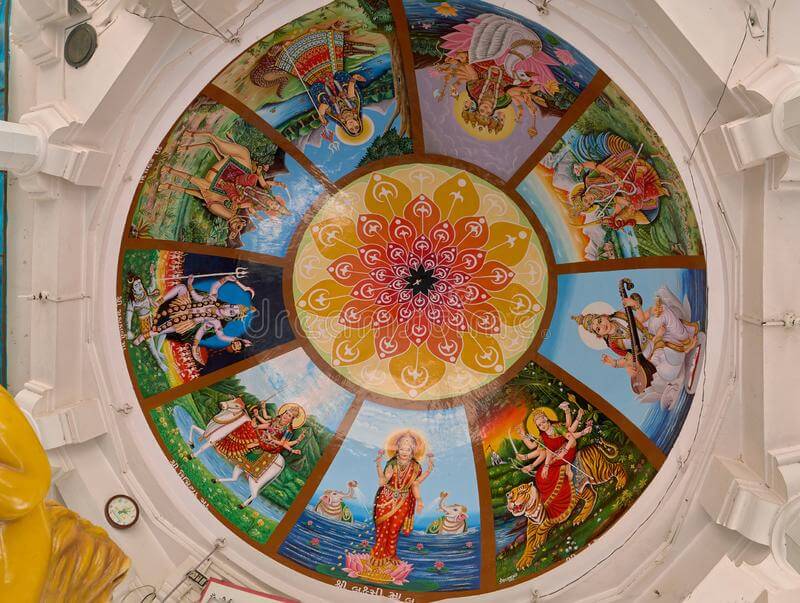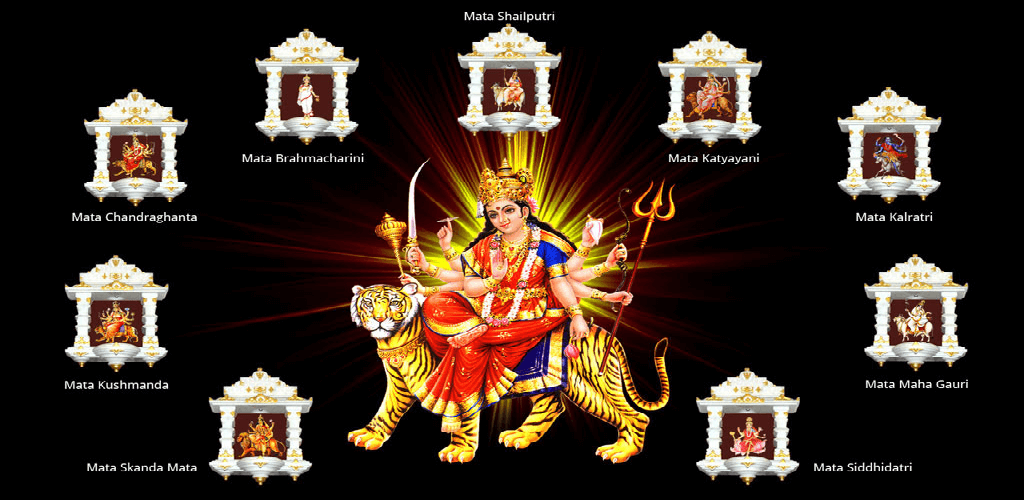Reading Time: 6 minutes
Goddess Durga is worshipped as vegetation, soil, and human form. Tapti elucidates her nine forms, Navdurga and tells us about her homecoming – an exclusive Special Feature for Different Truths.

Mahalaya, the auspicious day, heralds the advent of Goddess Durga. It is an invocation or an invitation to the Mother Goddess to descend on earth. This Homecoming of the Goddess sets the festive mode. Nature is attuned to the celebration with its bright clear blue skies, floating clouds and swaying of the Kaash Phool in the soft breeze. The auspicious Hindu festival of Navratri honours the nine forms of Maa Durga.
During this nine-day festival, devotees worship the nine avatars of Maa Durga. It is marked for nine days and nights and honours Goddess Durga. Devotees of Maa Durga follow several rituals, observe fasts (vrat), and wear new clothes during this time. The nine avatars of Maa Durga or Shakti, also known as Navdurga or the nine forms of Durga. Drik Panchang says the concept of Navdurga originates from Goddess Parvati, who is considered the supreme power among all goddesses. Devotees worship the nine avatars of Maa Durga and pray.
The first day of Navratri is dedicated to Maa Shailputri.
The first day of Navratri is dedicated to Maa Shailputri. She was the avatar of Goddess Parvati when she took birth as Lord Himalaya’s daughter, according to Drik Panchang. In Sanskrit, Shail means the mountain. Therefore, she is known as Shailputri, the daughter of the mountain.
The second day is dedicated to Goddess Brahmacharini, Goddess Parvati, when she was unmarried. People offer sugar to Goddess Brahmacharini to increase the life expectancy of their family members.
Maa Chandraghanta is worshipped on the third day. She is also known as Chandrakhanda, Chandika or Rannchandi, and has ten arms and holds an assortment of weapons in her hands.
Devotees pray to Maa Kushmanda on the fourth day.
Devotees pray to Maa Kushmanda on the fourth day. She is known to have created the universe with her smile. The Goddess rides a lion and is depicted with eight hands holding a kamandal, bow, arrow, lotus, trident, a jar of nectar, mace, and a discus.
The fifth day of Navratri is dedicated to Goddess Skandamata, the fifth manifestation of Goddess Durga and the mother of Lord Kartikeya, chosen by the devatas as their commander-in-chief in the war against the demons.
On the sixth day of Navaratri, devotees worship Goddess Katyayani. She is the sixth form amongst Navadurga. According to Hindu mythology, Lord Brahma, Vishnu, and Shiva combined their energies to create Maa Katyayani, who killed the demon Mahishasura.
Kalaratri, the most ferocious form of Goddess Durga, is worshipped on Saptami – the seventh day.
On the seventh day of Navaratri, devotees worship Goddess Kaalratri. Kalaratri, the most ferocious form of Goddess Durga, is worshipped on Saptami – the seventh day. Among the mother’s many valiant and aggressive forms, she is the fiercest form of the Goddess. She rides a donkey and has a dark complexion and long untied hair. It is said that when Goddess Parvati removed her outer golden skin to kill demons named Shumbha and Nishumbha, she was known as Goddess Kalaratri. This manifestation is India’s most feared and worshipped form after Goddess Mahakali. She has a dark complexion, dishevelled hair, and a fearless posture.
Maa Mahagauri is worshipped on the eighth day of Navratri. She symbolises purity, serenity, and tranquillity. Devotees pray to her earnestly, as it is believed that she can fulfil all their desires.
Devi Siddhidatri is worshipped on the ninth day of Navratri. She makes the impossible possible and brings miracles into life. Devotees pray to Maa Siddhidatri on the ninth day of Navratri. She is the ninth form of Maa Durga. Goddess Siddhidatri takes away ignorance from her devotees and grants them knowledge. She sits on a lotus flower and rides a lion. Folks say that when Goddess Siddhidatri appeared from the left half of Lord Shiva, he came to be known as Ardhanarishwara.
One of the Purana stories narrates that when gods worshipped her to get rid of Mahishasura, Devi Durga appeared in the Himalayas with ten hands.
One of the Purana stories narrates that when gods worshipped her to get rid of Mahishasura, Devi Durga appeared in the Himalayas with ten hands. Another Purana tells a different story: Sri Ramachandra, before killing Ravana, promised to worship Devi Bhagabati with 108 lotus flowers and kept the flowers ready. But the Goddess wanted to test his devotion and hid away one lotus. Rama was in a serious problem that his promised puja would be incomplete and might enrage the Goddess. He had wide beautiful eyes like louts and was called Padmalochan or the Lotus-eyed. He decided to take out his one eye and offer it to the Goddess. As he was ready with a weapon to gorge out one eye, the Devi appeared and blessed him with fulfilling his desire.

The idol of Devi Durga is made of clay. She is worshipped as vegetation, soil, and human form.
According to Chandi Purana, Unity is Strength.
According to Chandi Purana, Unity is Strength. When gods united and prayed, Devi Durga appeared. Shiva’s strength created Devi’s face. Shiv is mostly in meditation, with a calm mind to face any hassles. Shiva’s yogic serenity was passed to her. Vishnu created her strength in her hands, and Brahma created her legs to walk and be creative.
Other Gods decorated her with their various weapons. Shiva gave his Shula, trident, and Vishnu his chakra or divine disc. Brahma gave her the string of Rudraksha.
The Chandi Purana says that Devi is called Durga because she killed the demon Durgama, who tortured the people immensely.
When we visit the pandal of Durga puja, one finds a plantain plant by the side of Ganesha. The plant is covered with a white sari with a red border, like a newlywed woman with her head covered. She is usually called Kala-bou. But it is Navpatrika, nine leafy plants, namely Banana, Kochu or bulbs, Turmeric, Jayanti, Bail, Pomegranate, Ashoka, Maan roots and Paddy.
Mother worship is seen from the ages of Indus civilisation, rooted in nature worship.
Mother worship is seen from the ages of Indus civilisation, rooted in nature worship in different forms like plants and animals.
Mother goddess riding a lion is a very ancient concept. Her first figurine was found in Turkey, with a heavy, rounded figure with two lions on both sides. She looks heavy because of representing earth.
The Goddess with the lion came to be known as Cybele/Kybeli in Greece at a later age. Because of the lions, she became associated with mountains. In Indus civilisation, she is seen riding a tiger, not a lion. In general, worship of the Mother Goddess was universal, associated with lions or tigers.
In India, during the Kushana period, we find their main Goddess Nana, also known as Ommo, which may be a derivation of Uma. It continued later also through the ages. In Bengal, she was initially called Devi Chandi, derived from Chandri or moon. It later became Durga.
In most ancient civilisations, sacrifice was a religious ritual.
In most ancient civilisations, sacrifice was a religious ritual. In Chandraketugarh of Gangaredai, we find that goat sacrifice was prevalent in the worship of Mother with her four children by her side. The sacrifice of buffalo was prevalent, which later added a new feature to the Goddess as the demon Mahiashasura.
Mahabharata mentions Shiva as the killer of buffalo, which probably got associated with his female form when we find Arjuna praying to the Goddess who devours the buffalo’s blood.
Along with the old traditions involved in Durga Puja, UNESCO has given a Heritage tag to the festival this year.
In Bengal, the Durga puja festival is performed with much grandeur, across villages and cities, with people of different castes and colours. This annual festival is for all indulging in enjoying the rituals and life with aspects like art, culture, food, singing, dancing, dressing up, etc. Along with the old traditions involved in Durga Puja, UNESCO has given a Heritage tag to the festival this year.
But very soon, the excitement of festivity comes to an end on the tenth day, the day of immersion when every Bengali becomes emotional and heavy-hearted,
According to religious belief, God is omnipresent. Hence the idol is made with five elements of nature as a symbol of the human form; later, this clay idol is worshipped as God is present there also. The last stage of this Durga puja is immersion in the waters.
According to Hinduism, the Supreme God residing in our hearts is formless. To worship them, a human form is created as a clay idol.
In water, the idol gets dissolved. According to Hinduism, the Supreme God residing in our hearts is formless. To worship them, a human form is created as a clay idol. While immersion, it is prayed, “Oh Mother Goddess, you return to your formless self, but we remember you in our mind till you come back next year.”
The devotees exchange good wishes, sweets, and goodies. They embrace each other, wishing happiness, health and prosperity for the following year.
Picture : Feature from wall paper and insert photography by Anil Dave Dreamstime.com
















